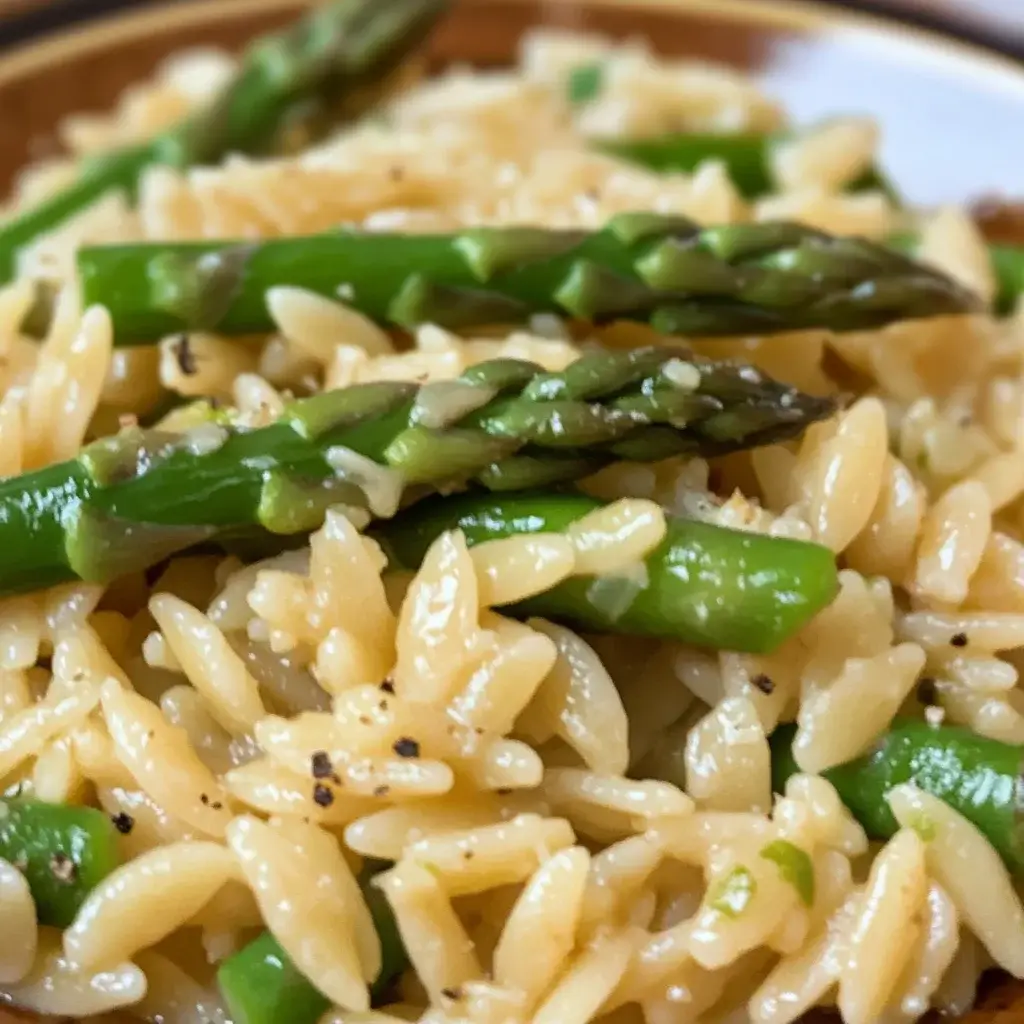In our home, weeknight dinners need to be quick, satisfying, and, if possible, sneak in some extra veggies without a battle at the table. That’s where this Asparagus and Parmesan Orzo recipe has become an absolute champion. From the moment the aroma of sautéed garlic and toasted orzo fills the kitchen, everyone starts gathering around, eager for a taste. My kids, who are sometimes skeptical of anything green, gobble this down without a peep, declaring it “cheesy pasta!” And honestly, they aren’t wrong – the creamy Parmesan coats each grain of orzo and tender piece of asparagus in a blanket of deliciousness. It’s a dish that feels both comforting and light, perfect for transitioning from the heavier meals of winter to the fresh flavors of spring. If you’re looking for a vegetarian side dish that can easily become a light main course, or simply want to add a touch of Italian elegance to your dinner table, look no further. This Asparagus and Parmesan Orzo is guaranteed to become a new family favorite.
Ingredients for Asparagus and Parmesan Orzo
Here are the simple, fresh ingredients you’ll need to create this delectable Asparagus and Parmesan Orzo dish. Quality ingredients are key to maximizing the flavor of this recipe, so choose the best you can find!
- Orzo Pasta: 1 cup, uncooked. This rice-shaped pasta forms the base of our dish, offering a delightful texture and slightly nutty flavor.
- Asparagus: 1 pound, trimmed and cut into 1-inch pieces. Fresh asparagus is the star vegetable, bringing a vibrant green color and springlike taste. Choose firm spears for the best texture.
- Vegetable Broth: 4 cups. This liquid is used to cook the orzo, infusing it with flavor and creating a creamy consistency. Low sodium is recommended to control salt levels.
- Parmesan Cheese: 1 cup, freshly grated, plus extra for serving. Parmesan provides a salty, umami-rich, and nutty flavor that is essential for the dish’s creamy texture and savory profile. Use good quality Parmigiano-Reggiano for the best results.
- Yellow Onion: ½ medium, finely diced. Onion forms the aromatic base, adding depth and sweetness to the dish.
- Garlic: 2 cloves, minced. Garlic is a flavor powerhouse, contributing pungent and savory notes that complement the asparagus and Parmesan.
- Olive Oil: 2 tablespoons. Used for sautéing, olive oil adds a fruity and rich element to the dish and helps to cook the onion and garlic beautifully. Extra virgin olive oil is preferred for its flavor.
- Butter: 2 tablespoons. Butter adds richness and helps create a velvety texture in the orzo. You can use salted or unsalted, adjusting seasoning accordingly.
- Fresh Lemon Juice: 1 tablespoon. Lemon juice brightens the flavors and adds a touch of acidity, balancing the richness of the Parmesan and butter. Freshly squeezed is always best.
- Fresh Parsley: ¼ cup, chopped. Parsley provides a fresh, herbaceous note and a pop of color, enhancing the overall presentation and flavor.
- Salt and Black Pepper: To taste. Essential seasonings to enhance all the flavors in the dish. Freshly ground black pepper is recommended for its bolder taste.
Instructions for Making Asparagus and Parmesan Orzo
Follow these simple, step-by-step instructions to create a perfect Asparagus and Parmesan Orzo every time. This recipe is designed to be straightforward and easy to follow, even for beginner cooks.
- Sauté Aromatics: Heat olive oil and butter in a large, heavy-bottomed pot or Dutch oven over medium heat. Add the diced onion and sauté until softened and translucent, about 5 minutes. Stir occasionally to prevent browning.
- Add Garlic and Orzo: Add the minced garlic to the pot and cook for another minute until fragrant, being careful not to burn it. Stir in the uncooked orzo and cook for 2-3 minutes, stirring constantly, until the orzo is lightly toasted and coated in the oil and butter mixture. Toasting the orzo enhances its nutty flavor and helps it cook evenly.
- Incorporate Vegetable Broth: Pour in the vegetable broth, ensuring it covers the orzo. Season with salt and pepper. Bring the mixture to a boil, then reduce the heat to low, cover the pot, and simmer for 10-12 minutes, or until the orzo is al dente and has absorbed most of the broth. Stir occasionally during cooking to prevent sticking and ensure even cooking.
- Add Asparagus: During the last 3-4 minutes of cooking time, gently stir in the chopped asparagus. This timing allows the asparagus to become tender-crisp and retain its vibrant green color. Avoid overcooking the asparagus, as it can become mushy.
- Stir in Parmesan and Lemon: Once the orzo is cooked and the asparagus is tender-crisp, remove the pot from the heat. Stir in the grated Parmesan cheese and lemon juice. Stir vigorously until the Parmesan is completely melted and the orzo is creamy and well combined. The heat from the orzo will melt the cheese beautifully, creating a luscious sauce.
- Finish and Serve: Stir in the chopped fresh parsley. Taste and adjust seasoning with salt and pepper as needed. Serve immediately, garnished with extra grated Parmesan cheese, if desired. The dish is best served hot to enjoy its creamy texture and vibrant flavors.
Nutrition Facts for Asparagus and Parmesan Orzo
This Asparagus and Parmesan Orzo is not only delicious but also offers a good source of several nutrients. Please note that these values are approximate and can vary slightly based on specific ingredients and serving sizes.
- Serving Size: Approximately 1 cup
- Calories: 350 kcal
- Protein: 12g
Preparation Time for Asparagus and Parmesan Orzo
This recipe is designed for quick and efficient preparation, perfect for busy weeknights or when you need a flavorful side dish in a hurry.
- Prep Time: 15 minutes. This includes washing and trimming the asparagus, dicing the onion, mincing the garlic, grating the Parmesan cheese, and chopping the parsley. Efficient prep work makes the cooking process smooth and enjoyable.
- Cook Time: 20 minutes. This includes sautéing the aromatics, toasting the orzo, simmering with broth, and cooking the asparagus. The dish comes together quickly once the cooking process begins.
- Total Time: 35 minutes. From start to finish, you can have this flavorful and satisfying Asparagus and Parmesan Orzo on the table in just over half an hour.
How to Serve Asparagus and Parmesan Orzo
Asparagus and Parmesan Orzo is incredibly versatile and can be served in a variety of ways to suit different occasions and preferences. Its creamy texture and bright flavors make it a welcome addition to any meal.
As a Side Dish:
- Alongside Grilled or Roasted Chicken or Fish: The creamy orzo perfectly complements the lean protein and adds a flavorful carbohydrate element to the meal.
- With Vegetarian Mains: Serve it with lentil loaf, grilled halloumi, or stuffed bell peppers for a complete and satisfying vegetarian dinner.
- Part of a Spring or Summer Buffet: Its vibrant color and fresh flavors make it an ideal dish for potlucks, barbecues, and outdoor gatherings.
- Accompanying Roasted Vegetables: Pair it with roasted carrots, broccoli, or Brussels sprouts for a hearty and vegetable-forward meal.
As a Light Main Course:
- Add Protein: Stir in cooked chickpeas, white beans, or grilled tofu to boost the protein content and make it a more substantial vegetarian main course.
- Top with a Fried Egg: A perfectly fried egg adds richness and extra protein, transforming it into a simple yet satisfying meal.
- Serve with a Salad: Pair it with a fresh green salad or a tomato and cucumber salad to create a balanced and light lunch or dinner.
- Enhance with More Vegetables: Add other spring vegetables like peas, zucchini, or artichoke hearts to make it a more vegetable-rich main course.
Serving Tips:
- Serve Hot: Orzo is best served immediately while it’s hot and creamy.
- Garnish: Garnish with extra grated Parmesan cheese and a sprinkle of fresh parsley for visual appeal and added flavor.
- Lemon Wedge: Offer a lemon wedge on the side for those who like an extra burst of citrus.
- Warm Plates: Serve on warm plates to keep the orzo at the perfect temperature for longer.
Additional Tips for Perfect Asparagus and Parmesan Orzo
Here are eight helpful tips to ensure your Asparagus and Parmesan Orzo is absolutely perfect every time, enhancing both flavor and texture.
- Use Fresh, High-Quality Asparagus: Opt for firm, bright green asparagus spears with tightly closed tips. Fresh asparagus has a sweeter, more delicate flavor than older, wilted asparagus. If possible, use asparagus that is in season for the best taste.
- Don’t Overcook the Asparagus: Add the asparagus towards the end of the cooking process to ensure it remains tender-crisp and retains its vibrant green color. Overcooked asparagus can become mushy and lose its appealing texture.
- Toast the Orzo for Deeper Flavor: Toasting the orzo in the pot before adding the broth enhances its nutty flavor and adds a layer of complexity to the dish. This step is crucial for developing a richer taste.
- Use Freshly Grated Parmesan Cheese: Freshly grated Parmesan melts more smoothly and has a superior flavor compared to pre-grated cheese. For the best results, use Parmigiano-Reggiano cheese.
- Don’t Skimp on the Butter and Olive Oil: These fats are essential for creating a creamy texture and carrying the flavors of the dish. They also help to toast the orzo and sauté the aromatics effectively.
- Adjust Broth Amount for Desired Consistency: If you prefer a drier orzo, start with slightly less broth. For a creamier, more risotto-like consistency, you can add a little extra broth or even a splash of white wine during cooking.
- Season Generously: Taste and season the orzo throughout the cooking process. Salt and pepper are crucial for enhancing the flavors of all the ingredients. Don’t be afraid to season generously, especially after adding the Parmesan cheese, which can absorb some of the saltiness.
- Make it Ahead (Partially): You can prepare the orzo base ahead of time, up to the point where you add the asparagus. Store the cooked orzo base in the refrigerator and reheat it with a little extra broth or water before adding the fresh asparagus and Parmesan just before serving. This makes it a great dish for meal prepping.
Frequently Asked Questions (FAQ) about Asparagus and Parmesan Orzo
Here are eight frequently asked questions about Asparagus and Parmesan Orzo, covering common queries and helpful tips to ensure your cooking experience is smooth and successful.
Q1: Can I use frozen asparagus instead of fresh?
A: While fresh asparagus is highly recommended for the best flavor and texture, you can use frozen asparagus in a pinch. If using frozen asparagus, thaw it completely and pat it dry before adding it to the orzo. Add it a minute or two later than fresh asparagus as it tends to cook faster. Keep in mind that frozen asparagus might be slightly softer in texture.
Q2: Can I make this recipe vegan?
A: To make this recipe vegan, you would need to substitute the Parmesan cheese and butter. Use a vegan Parmesan cheese alternative and vegan butter. Nutritional yeast can also be added for a cheesy flavor boost. Ensure your vegetable broth is also vegan-friendly.
Q3: Can I add other vegetables to this orzo dish?
A: Absolutely! Asparagus and Parmesan Orzo is a great base for adding other vegetables. Consider adding peas, zucchini, mushrooms, sun-dried tomatoes, or spinach. Add vegetables that require longer cooking times along with the orzo, and quicker-cooking vegetables like spinach or peas during the last few minutes of cooking.
Q4: How do I store leftover Asparagus and Parmesan Orzo?
A: Store leftover orzo in an airtight container in the refrigerator for up to 3 days. The orzo may absorb some of the liquid and become drier upon refrigeration.
Q5: How do I reheat leftover Asparagus and Parmesan Orzo?
A: Reheat leftover orzo gently in a saucepan over low heat. Add a splash of vegetable broth or water to loosen it up and restore its creamy consistency. You can also reheat it in the microwave, but be sure to stir it occasionally to ensure even heating.
Q6: Can I use chicken broth instead of vegetable broth?
A: Yes, you can substitute chicken broth for vegetable broth if you are not strictly vegetarian. Chicken broth will add a richer, meatier flavor to the orzo. However, vegetable broth keeps the dish vegetarian and allows the flavors of asparagus and Parmesan to shine.
Q7: What if I don’t have orzo pasta? Can I use another type of pasta?
A: If you don’t have orzo, you can use other small pasta shapes like ditalini, acini de pepe, or even broken spaghetti or linguine. Cooking times may vary slightly, so adjust accordingly and follow package instructions for al dente pasta.
Q8: Can I make this recipe gluten-free?
A: Orzo pasta is not gluten-free as it is made from wheat. To make this recipe gluten-free, you would need to substitute the orzo with a gluten-free orzo alternative or another gluten-free grain like quinoa or risotto rice. If using rice, follow risotto cooking techniques for a creamy texture. Be sure to check all other ingredients to ensure they are also gluten-free if necessary.
Print
Asparagus and Parmesan Orzo
Ingredients
Here are the simple, fresh ingredients you’ll need to create this delectable Asparagus and Parmesan Orzo dish. Quality ingredients are key to maximizing the flavor of this recipe, so choose the best you can find!
- Orzo Pasta: 1 cup, uncooked. This rice-shaped pasta forms the base of our dish, offering a delightful texture and slightly nutty flavor.
- Asparagus: 1 pound, trimmed and cut into 1-inch pieces. Fresh asparagus is the star vegetable, bringing a vibrant green color and springlike taste. Choose firm spears for the best texture.
- Vegetable Broth: 4 cups. This liquid is used to cook the orzo, infusing it with flavor and creating a creamy consistency. Low sodium is recommended to control salt levels.
- Parmesan Cheese: 1 cup, freshly grated, plus extra for serving. Parmesan provides a salty, umami-rich, and nutty flavor that is essential for the dish’s creamy texture and savory profile. Use good quality Parmigiano-Reggiano for the best results.
- Yellow Onion: ½ medium, finely diced. Onion forms the aromatic base, adding depth and sweetness to the dish.
- Garlic: 2 cloves, minced. Garlic is a flavor powerhouse, contributing pungent and savory notes that complement the asparagus and Parmesan.
- Olive Oil: 2 tablespoons. Used for sautéing, olive oil adds a fruity and rich element to the dish and helps to cook the onion and garlic beautifully. Extra virgin olive oil is preferred for its flavor.
- Butter: 2 tablespoons. Butter adds richness and helps create a velvety texture in the orzo. You can use salted or unsalted, adjusting seasoning accordingly.
- Fresh Lemon Juice: 1 tablespoon. Lemon juice brightens the flavors and adds a touch of acidity, balancing the richness of the Parmesan and butter. Freshly squeezed is always best.
- Fresh Parsley: ¼ cup, chopped. Parsley provides a fresh, herbaceous note and a pop of color, enhancing the overall presentation and flavor.
- Salt and Black Pepper: To taste. Essential seasonings to enhance all the flavors in the dish. Freshly ground black pepper is recommended for its bolder taste.
Instructions
Follow these simple, step-by-step instructions to create a perfect Asparagus and Parmesan Orzo every time. This recipe is designed to be straightforward and easy to follow, even for beginner cooks.
- Sauté Aromatics: Heat olive oil and butter in a large, heavy-bottomed pot or Dutch oven over medium heat. Add the diced onion and sauté until softened and translucent, about 5 minutes. Stir occasionally to prevent browning.
- Add Garlic and Orzo: Add the minced garlic to the pot and cook for another minute until fragrant, being careful not to burn it. Stir in the uncooked orzo and cook for 2-3 minutes, stirring constantly, until the orzo is lightly toasted and coated in the oil and butter mixture. Toasting the orzo enhances its nutty flavor and helps it cook evenly.
- Incorporate Vegetable Broth: Pour in the vegetable broth, ensuring it covers the orzo. Season with salt and pepper. Bring the mixture to a boil, then reduce the heat to low, cover the pot, and simmer for 10-12 minutes, or until the orzo is al dente and has absorbed most of the broth. Stir occasionally during cooking to prevent sticking and ensure even cooking.
- Add Asparagus: During the last 3-4 minutes of cooking time, gently stir in the chopped asparagus. This timing allows the asparagus to become tender-crisp and retain its vibrant green color. Avoid overcooking the asparagus, as it can become mushy.
- Stir in Parmesan and Lemon: Once the orzo is cooked and the asparagus is tender-crisp, remove the pot from the heat. Stir in the grated Parmesan cheese and lemon juice. Stir vigorously until the Parmesan is completely melted and the orzo is creamy and well combined. The heat from the orzo will melt the cheese beautifully, creating a luscious sauce.
- Finish and Serve: Stir in the chopped fresh parsley. Taste and adjust seasoning with salt and pepper as needed. Serve immediately, garnished with extra grated Parmesan cheese, if desired. The dish is best served hot to enjoy its creamy texture and vibrant flavors.
Nutrition
- Serving Size: one normal portion
- Calories: 350
- Protein: 12g






